comments? corrections?
email me at
lukerobt@history.ucsb.edu
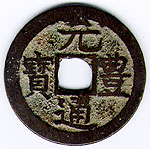
|
comments? corrections? |
Nagasaki
export coins
 |
|
The Tokugawa era (1600-1868) is sometimes erroneously described as the era when Japan shut itself off from the outside world and became a "closed country." The ruling Tokugawa regime greatly restricted sites of foreign trade following the 1630's and did prohibit (with certain exceptions) the travel of Japanese abroad in the interests of maintaining peace at home and abroad. Insofar as this goes Japan was partially "closed." However the volume of foreign trade did not decline, indeed it continued to grow until the early 1700's and throughout the Tokugawa period Japan maintained trading relations with just about every country within a thousand miles, and with the Dutch East India Company as well. Furthermore, Japanese coinage and bullion played an important role in the East Asian economy until the early eighteenth century. The Tokugawa clan gave rights to certain foreign trade to the following regional daimyo domains: Tsushima domain had a monopoly of the Korean trade carried out through the merchant quarter granted it in Pusan by the Korean king; Satsuma domain monopolized the Ryuukyuu trade through Kagoshima, and Matsumae domain monopolized the Ainu trade in Ezo (Hokkaido). Each of these sites were also sites of indirect trade with China--high quality silk and cloth being the main import into Japan. The Tokugawa clan itself opened up only one port for direct trade with with China and Southeast Asia and with the Dutch East India Company, and this was the city of Nagasaki. Since all other ports than the above were closed to foreign trade Nagasaki was a most important site of interface with Asia and Europe during the Tokugawa era. In the 17th century Japan was one of the great silver producers of the world. China imported silver from Japan and the Americas in great quantities, and indirectly was an economic engine for Europe and its colonies in America. Japanese mines also produced significant quantities of copper and Nagasaki's main exports were silver and copper. From the year 1659 until about1685 great amounts of copper coins were minted in Nagasaki and exported. These coins were based on locally carved mother coins but used the words of Song era Chinese coins. By far the most common is the formal script (kaishou) Genpou Tsuuhou (Yuan Feng Tong Bao) pictured above. It is easily distinguished from the Chinese Song coin because the Song coin exists mainly in seal script and semi cursive script. The Nagasaki coin nevertheless comes in an enormous variety of character shapes and sizes, which is suprising because the coins all come from one mint. I cannot think of any Kan'ei tsuuhou mint which produced anything near this variety. Below I present examples of some of the common varieties of the Nagasaki coins and attempt a typology based upon Japanese practices of distinguishing coins. This is nowhere near exhaustive; indeed contains much less than half of the common varieties. I will write the type descriptions in Japanese and in English translation. If your browser does not support Japanese characters the Japanese will appear garbled but you can safely ignore it. |
|
This is the "small, vigorous character" version of the Nagasaki coin. It is identifiable by the right bottom portion of the Gen character at the top of the coin. This portion forms an angular outside corner rises up sharply and rather high. This is a very handsome example of the coin. 遒勁小字 I have no examples but The "large, vigorous character" version is rather uncommon, and both the large and small have a rare variant. The variation is that the left leg of the Gen character is cut through at the bottom. This variant is known as the "stone kicking" variety. All varieties of the Genpou tsuuhou coin displayed here are 24mm in width. |
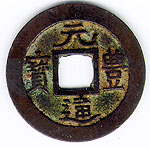 |
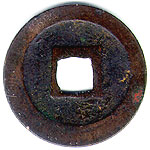 |
|
This one is a common basic variant of the large vigorous character type. The "hou" character is written differently. The portion that is normally written "ji" 尓 is instead written with a variant that is composed of hito 人 and shou 小. This is nearly like the character for "strange" and so it is known as the "strange 'hou.'" This one has some scratches on the back. 珍寳 |
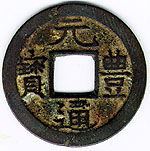 |
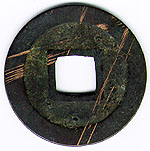 |
|
This is another example of the "strange hou" variety just above. 珍寳 |
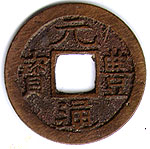 |
 |
|
This coin was found in the Berantas river in Java and suggests the long
range of trade. The front has some encrustations but almost no wear. The
back is very rough. This may be due to deterioration or maybe poor casting.
I thought the latter possibility strange given the quality of the front,
but the similar coin below also has a poor back. 小頭通 昂寳昂通 A Japanese friend suggested the following detailed description of this coin. The translation is "Major category: large character small shell "hou", expansive character, small top "tsuu." Minor categories: rearing up tsuu, rising tsuu, rising "hou" rising tsuu. 大分類:大字小貝宝、肥字、小頭通 小分類:仰通、昂通 、昂宝昂通 |
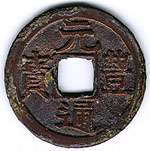 |
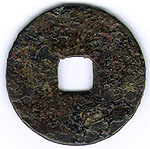 |
|
This coin, bought in Japan, is similar to the one above but has a casting
error on the bottom over the "tsuu" character. This one has a casting error on the bottom, perhaps a crack made when removing the coin from the "tree." 小頭通 広元 |
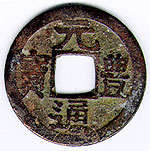 |
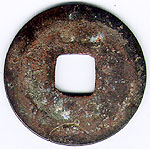 |
|
This one is a large character coin of the "expansive character" type. the characters seem to spread out to fill up their space. 肥字 |
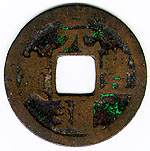 |
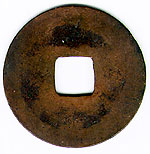 |
|
This is an example of the "weak character" type. "Weak character" refers to the fact that they are somehow lifeless but this is hard to recognize if you are not very familiar with brush writing. One thing I have noticed about this type is that all of the ones so identified seem to have middle to large characters and the top part of the right "hou" character expands as it goes upwards--like a flower pot shape. The "tsuu" is interesting because it rises and the whole bottom is clear of the rim. 容弱 昂通 |
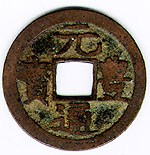 |
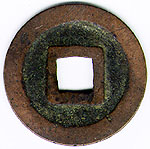 |
|
This is an example of the "weak character" type. The top part of the right "hou" character expands upwards. The left "hou" character is medium sized. In this case the "tail" of the "gen" character is long and so its subset it known as known as the "long tailed gen" type. 容弱 長尾元 |
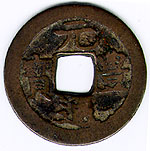 |
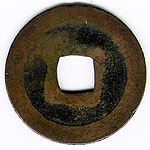 |
|
This one has characters simlar to the one above but is a better cast and in much better condition. The rim is thinner however. 容弱 長尾元 |
 |
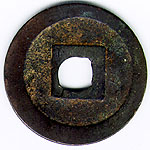 |
|
This is an example of the "weak character variety" but of the subdivision "long gen." The left leg of the gen is longer and it seems to lean down on that leg. The "tsuu" character rises up here so I have added "rising tsuu" but I am not sure if it is a recognized type. The back of this coin has a lot of character. 容弱 長元 昂通 |
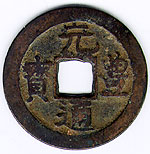 |
 |
|
This one is of the small character variety. 小字 |
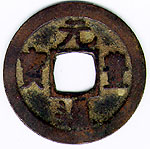 |
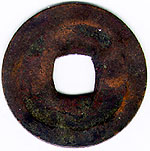 |
|
This one is a small character variety. The Hou on this one is particularly small and its bottom stroke arches up to the left. 小字 |
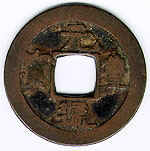 |
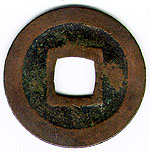 |
|
Another common basic variant is the "one dot tsuu" set. This one has characters of middling size. Two minor type characteristics are rising "hou" and leaning "gen" 単点通中字仰元昂豊 |
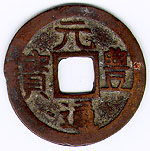 |
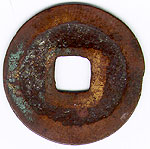 |
|
This one is also a "one dot tsuu" but the characters are quite different. The "gen" character is lively and called a "jumping gen" and the "tsuu" character is rising up and compacted so it is known as the "compacted tsuu" 単点通縮通跳元 |
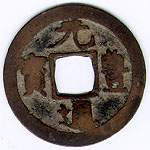 |
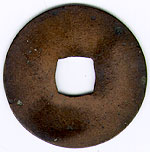 |
| I am not sure about this coin below. It is a privately minted counterfeit version of the Nagasaki Genpou coin. Whether it is made in Japan or in Annam is something I do not know. It is thin like the Annam floater type (see Annam page) but the metal content is like the Nagasaki coins. It is 22mm in diameter and only about .6 mm in thickness-- a bit smaller than all of the ones above, but I have enlarged the picture to bring out the details of this sloppy coin. The characters seem to have been recut from a Nagasaki coin but they may have been carved from scratch on a new mother coin. The fact that the coin is smaller suggests that the mother coin for this was the same size as a circulating Nagasaki genpou. At any rate, the casting skill was poor so they do not appear clearly. Note also the uneven shape of the central hole. The extensive wear on the coin shows that obvious counterfeit or not it circulated well. |
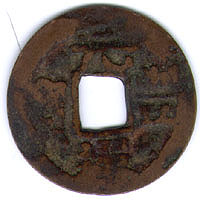
|
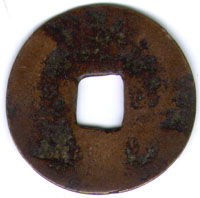 |
|
This Nagasaki coin is the cursive version of the above Genpou Tsuuhou. The characters are written in a fascinatingly dynamic way. Skillful or clumsy I am not sure, but they seem to whirl around the center square hole like a tornado around the vortex. A Japanese collector friend kindly gave this coin to me. This coin and the ones below are moderately uncommon. Unlike the immense variety of the formal script Genpou tsuuhou above, they each exist in only one basic type with only very minor variations if at all. 24mmx1mm 元豊通宝 |
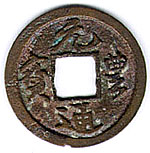 |
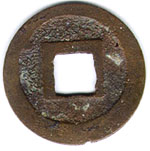 |
|
This Nagasaki coin is the seal script version of the above Genpou Tsuuhou. It is the most easy of the three Genpou Tsuuhou varieties to confuse with the Chinese Yuan Feng Tong Bao coins upon which it is based. 24mmx1mm 元豊通宝 |
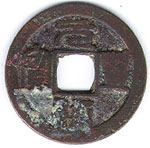 |
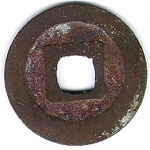 |
|
This Nagasaki coin is called a Shoufu Genpou and is based on the Song Chinese Xiang Fu Yuan Bao coin. Like all Nagasaki coins it was first minted in 1659. 24mmx1mm 祥符元宝 |
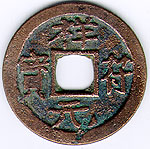 |
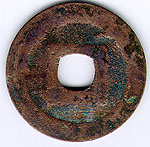 |
|
This Nagasaki coin is called a Kinei Genpou and is based on the Song Chinese Xi Ning Yuan Bao coin. It was first minted in 1659. A Japanese collector friend kindly gave this coin to me. 24mmx1mm 熙寧元宝 |
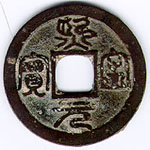 |
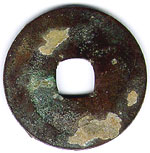 |
|
This Nagasaki coin is called a Tensei Genpou and is based on the Song Chinese Tian Shen Tong Bao. It was first minted in 1659. This handsome coin belongs to Bill Dunkle who kindly let me use the image. 24 mm x 1 mm 天聖元宝 |
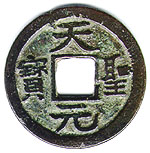 |
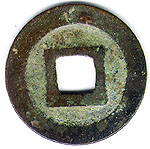 |